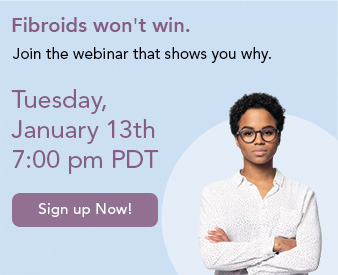The size of a fibroid is of the primary symptoms doctors determine whether treatment is required. That being said, the average woman’s uterus is approximately 3 inches long and shaped like a pear. Smaller fibroids may not cause any noticeable symptoms, so it is possible for them to go undetected. In contrast, larger fibroids can cause your uterus to enlarge, thus having more obvious changes with your body.
Uterine Fibroids Overview
The following is a quick recap of uterine fibroids and what to be aware of when looking at the context of fibroids and their varying sizes.
- Uterine fibroids are lumps or tumors that develop within uterine walls.
- Although they are tumors, they are almost always benign and not cancerous.
- Cancerous fibroids occurring are very rare (less than 1 in 1,000 chance), and is known as leiomyosarcoma.
- Having fibroids does not increase the risk of developing leiomyosarcoma.
- Having fibroids does not increase the likelihood of getting other forms of cancer in the uterus.
- Fibroids among women typically grow during childbearing and reproductive ages, so typically between one’s teenage years to their late 40’s or even into their 50’s.

How Large Can Fibroids Get?
Uterine fibroid sizes can range from as large as a melon to as small as a coin. According to my.cleavelandclinic.org: Fibroids may grow as a single nodule or in clusters and may range in size from 1 mm to 20 cm in diameter. A very large fibroid can even cause the uterus to expand to the size equivalent to a pregnancy heading into the 3rd trimester. Fibroids can further develop as a cluster of many small fibroids or form as one large, dominant fibroid.Fibroid Size Comparisons
Use the following guide as a reference point to generalize the size of fibroids from small, medium, and large.- Small (>1cm – 5cm)
- Size of a pea to a lime.
- Medium (5cm – 10 cm)
- Size of a peach to a large lemon.
- Large (10cm+)
- Size of a mango to a watermelon.
Effects of Larger Fibroids
As fibroids increase in size, their impact on the body becomes more significant. They can take up space meant for other organs and can cause discomfort or pain. Below are a few effects that can arise when fibroids grow past smaller sizes.
- Swelling of the abdomen
- Unusual weight gain
- Discomfort, then pain in the pelvis and lower back
- Increased urination
These are just a few possible signs of a larger fibroid. Here is a more in-depth look at the symptoms.
Fibroid Treatment
If you think you have fibroids, schedule an appointment for a professional diagnosis. One of our gynecologists will talk to you about your symptoms and perform a pelvic exam. We may order further testing including an imaging procedure such as an ultrasound. If diagnosed, uterine fibroid embolization may be your best treatment option; it has a 95% success rate with patients. Here at the Fibroid Treatment Collective, we offer free consultations in-office or over the phone. For more information on fibroids and their symptoms, feel free to contact us at 1 (866) 479-1523 or request a free consultation online.
Lola couldn’t believe how easy treatment was. Or how happy it made her.
Honestly I would say if you have fibroids, please take control of your body, of your life, do the research, because there are options.


